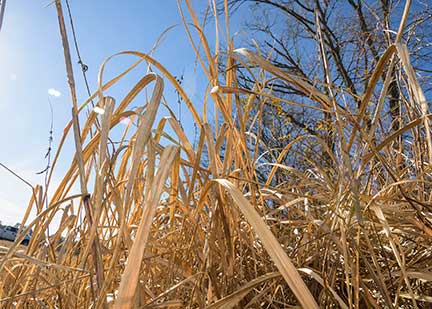News
The information presented on this page may be outdated. It may refer to situations which have changed or people who are no longer affiliated with the university. It is archived as part of Mississippi State University's history.
Now is the time to spot, treat cogongrass patches

Cogongrass will not be in bloom for at least another two months, but now is the time for people who suspect they may have this weed on their property to find out for sure. (Photo By: Kevin Hudson)
2/5/2015
By: Robert Nathan Gregory
The noxious weed is found most frequently in southeast Mississippi but has been documented in 73 of 82 counties. Cogongrass has no nutritional benefits and is detrimental to forage crops. Mississippi State University researchers and MSU Extension Service agents remain involved in a long-term effort to control the invasive grass from spreading more than it already has, and they are seeing results.
John Byrd, a weed scientist with the Mississippi Agricultural and Forestry Experiment Station and the MSU Extension Service, said cogongrass is easy to identify during the winter, and management should start with herbicide treatments in the early spring before it blooms.
"If left untreated, the invasive weed presents a major threat to desirable competing vegetation in any area where it is introduced," Byrd said. "While it is currently easy to identify, cogongrass is very difficult to control, which is why it has been listed as one of the worst weeds in the world."
More than 100 years ago, cogongrass entered the U.S. through the Port of Mobile and began its invasion of the South.
Byrd said patches of the weed are most commonly seen in pastures, wooded areas and roadsides. There are two main reasons why cogongrass is easier to identify while it is dormant, Byrd said. First, it typically grows in a large circle. It also has a color that is different from surrounding dormant grasses.
Byrd added that the weed tends to be found commonly in bermudagrass and bahiagrass and occasionally in Johnsongrass.
The spread of cogongrass has been such a problem in recent years that several state and federal agencies provided landowner assistance to treat the weed. Currently, however, the Mississippi Forestry Commission and the United States Department of Agriculture National Resources Conservation Service are the only sources of treatment assistance for Mississippi landowners.
"At one time we were trying to track populations across the state, and I ended up with so many dots on the map that there was no value to it," Byrd said.
Ernie Flint, central Mississippi regional Extension specialist and Attala County Extension agent, said concerned landowners regularly contact him with questions about invasive grasses. MSU Extension agents across the state have been trained to help those who have pest weed problems on their land, he said.
"Extension agents and county foresters should be able to identify them," Flint said. "Get somebody to go and confirm the site. Plot it with a GPS and report it to the Mississippi Forestry Commission. It can be a problem, but with a little bit of common sense and management, you can keep it pushed back."
The most effective treatment, Byrd said, is to spray a Roundup or Arsenal solution twice a year where cogongrass has surfaced. The first of those two applications should be a spray mix containing 0.6 fluid ounces of herbicide per gallon of water, which should be applied just before flowering starts in late April or early May.
The second spray should be a heavier dose applied in September or October four to six weeks before the first frost. Byrd suggested a spray mixture that contains 2.6 fluid ounces per gallon of Roundup or 1.3 fluid ounces per gallon of Arsenal.
"If you're using Arsenal, there's more flexibility in terms of when that application can be made," Byrd said. "The downside of using Arsenal is if you have hardwood vegetation close to the treatment zone, you might kill those hardwoods. It won't damage pine trees, but it can hurt hardwoods."
Byrd said there has never been a major concern that the noxious weed might invade agronomic crops, such as cotton, corn or soybean. Rather, the greatest threat is for no-till crops, such as timber, pecans and blueberries.
"When one considers where cogongrass grows in other countries and the crops infested in those countries, it is only a problem in areas with no soil disturbance," Byrd said. "Even no-tillage production of corn, soybean and cotton still contains frequent enough tillage to keep cogongrass out."
Flint said cogongrass poses an extreme threat to no-till crops if it is ignored. However, continuous research and efforts to help landowners and producers across the state have kept the problem from being ignored.
"I think we've reached an equilibrium in central Mississippi where there are people doing a moderate amount of control, and farmers are doing enough tilling that the appearance of cogongrass is not increasing at a rate that people thought it would," Flint said.
View More News